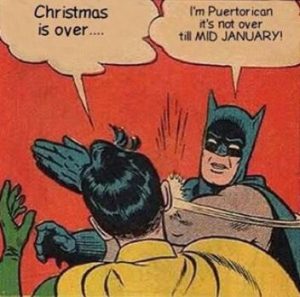This post is also available in:
 Español
Español
In Puerto Rico, the period after the 3 Kings Day (“Día de los Santos Reyes Magos”) is known as the “Octavitas“.
This tradition has changed through the decades. Unfortunately, it has been rapidly fading away. Therefore, it’s worth taking a quick review of this piece of Puerto Rican Christmas culture.
What are the “Octavitas”?
The current “Octavitas“, or of what remains of them, is a celebration that goes 8 days following 3 Kings Day (January 6th). It’s an extension of the Christmas season in Puerto Rico. Here, parrandas and parties are still considered part of the holiday season.
Many people think the “Octavitas” are just an excuse to extend the celebration of the Christmas holidays longer than in any other country.
With the Puerto Rican Christmas holiday season starting on the last Thursday of November (Thanksgiving) and going 8 days after “Día de los Reyes Magos”, it concludes in January 14. Therefore, it has a duration of over 1 1/2 months.
But if you think this is all a product of commercialism and secular party animals just stretching the holidays way too long, then think again.
Early Octavitas (true meaning)

Like many other celebrations during the holiday season, this one also had a religious origin. It’s timeframe was originally a little different from the current one.
The “Octavas“, as they were originally called, began following 3 days of commemorating each of the 3 “Reyes Magos”. It started with Gaspar on the very January 6th, then Melchor on the 7th, and Baltasar on the 8th.
On January 9th came a celebration to what was known the “3 Marías“. This is something that I don’t remember commemorating. Anyways, the same day began the “octavas“; the 8 days of celebrations.
This means the “octavas” went on until January 16th. That’s even longer than we celebrate them today.
People sang verses like:
“Se fueron los Reyes con mucha alegría, vienen las octavas…
…Dios nos de salud para celebrarlas.”
Other Definitions of “Octavitas“.
There is also the popular belief that the “Octavas” are the 8 days after the “Día de los Reyes Magos”. When those are done, then the “octavitas” begin for another 8 additional days of celebration. If they started with the traditional definition of January 9th, then these “octavitas” lasted until January 24th!
But as I stated above, the most popular convention has been that of the 8 days following Three Kings Day.
Hand-off to Fiestas de las Calles San Sebastian
The tradition of celebrating the “Octavitas” is dying fast as a result of the slowdown in “parrandas“. These are fading due to various socio-economic circumstances which have been impacting Puerto Rico the last couple of decades.
Note: you can also read the related blog “Is Asalto Navideño a Dying Tradition”.
The “Octavitas” are a part of Puerto Rican culture, and I hope you now have a better understanding of where the tradition of the “Octavitas” came from.
Finally, the “Octavitas” have also served as a great prelude of the Fiestas de la Calle San Sebastian, which follow on their footsteps.
If you want to know more about the origins and history of the Fiestas de la Calle San Sebastian, you can read “Fiestas de la Calle San Sebastian; a Great Puerto Rican Tradition”, or “Cabezudos of the Calle San Sebastian”.


FYI:
The celebrations go on until Las Fiestas de la Calle San Sebastian
”The Fiestas de la Calle San Sebastian were selected as the party of the planet in January by National Geographic.”
https://m.facebook.com/notes/verdanza-hotel/in-the-news-forbes-puerto-rico-is-top-holiday-destination/10150383461317294/
Pablo,
Thanks for sharing this!
[…] to be more current with 2021] In Puerto Rico, this will go on until mid-January with the “Octavitas“, which should really be called the “Octavas”, and then after a brief break, put […]
[…] the Calle San Sebastián festivities were scheduled after the “Octavitas“, the first “Cabezudos” of the 1950s represented religious figures, mostly the […]